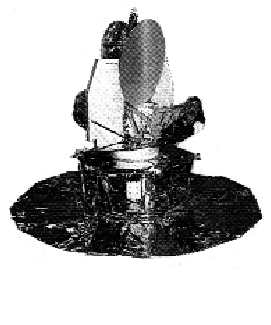 | ||
Nothing to Fear From NASA
By Fred Heeren
This Saturday, NASA will launch a small
spacecraft in hope of getting answers to big questions once
thought to belong to the exclusive domain of religion. The
discovery of the Big Bang - and the implications of an
instantaneous creation - came as more of a surprise to
cosmologists than to theologians. In a way, science has been
playing catch-up with religion ever since. Now scientists hope
to discover without help from the theologians what put the bang
in the Big Bang.
The new probe will be sent on a two-year
mission to measure tiny ripples, called anisotropy, in cosmic
radiation that has been flooding the universe since the
beginning of time. Named the Microwave Anisotropy Probe, or
MAP, the spacecraft will orbit the Sun beyond Earth's orbit,
where it can measure radiation temperature differences of just
20 millionths of a degree. These early temperature variations
represent what cosmologists call the “cosmic seeds”
that were destined to grow into stars and galaxies.
This is not the first attempt to study the
Big Bang’s afterglow. In 1990, the Cosmic Background
Explorer (COBE) satellite proved that cosmic radiation formed a
perfect “blackbody” spectrum, a detailed pattern
that scientists expected to see only if the entire universe was
once jammed into a very dense state. Now, MAP will measure one
million slices of the sky, each an angle less than a quarter of
a degree wide, yielding much finer measurements than COBE's
cruder seven-degree wedges could provide.
Those results brought scientists
information from about 300,000 years after the beginning. But
MAP should be able to detect gravitational waves, and these
could take us back to the tiniest fraction of a second after
time began. With this information we can start to explain how
the universe first started expanding.
The most popular explanation among
theorists is called inflation. Inflation theory suggests
that a quantum bubble, just a billionth the size of a proton
got stuck in a high energy, antigravity state, and this
propelled runaway growth in time’s first instant.
MIT’s Alan Guth, the father of inflation theory, is often
quoted as saying that inflation supplies the beginning to which
the big bang theory is the continuation. We’re left with
the impression that science is filling in the last spaces that
once required faith in a divine creator.
However, when I asked Mr. Guth if
inflation explains how the universe came out of absolutely
nothing, he told me: “Inflation itself takes a very small
universe and produces from it a very big universe. But
inflation by itself does not explain where that very small
universe came from.”
If scientists do detect the right kind of
early gravitational waves, and if a newer theory of
“eternal” inflation is proved correct, this
universe will be shown to be one of many universes, each
breaking away from the one before as a newly produced bubble.
It sounds as though “eternal” inflation, forever
churning out new universes, could finally take science beyond
the need for a beginning and a Beginner.
But it only sounds that way. At a
conference about “The Nature of Nature” at Baylor
University, Dr. Guth himself told a group of scholars:
“Eternal inflation is eternal into the future, not the
past.” Those bubble universes may keep inflating
eternally into the future, but we’re still left without
an explanation for what caused the first bubble.
Stephen Weinberg, who won a Nobel prize
for uniting two of nature’s fundamental forces, spoke at
the Baylor conference on behalf of the atheistic position. But
even he conceded that “the most powerful point” for
those more religiously inclined is “that the universe is
intelligible, governed by extremely simple laws, so that we are
left with the wonder.”
So let’s review what we do and
don’t know: We know that the universe had a beginning,
but we don't know why. We might find out that its expansion was
caused by inflation, but we still won't know why it inflated.
We know that the universe began with laws of physics that make
life possible, but we don't know why we have laws of physics.
So far, science is far better at answering
our “how” questions than our “why”
questions, leaving plenty of room for religion. Although he
hopes for a final theory to unify all physical law, Mr.
Weinberg actually made a convincing argument that religion has
nothing to fear from NASA. “When we have it,”
he pointed out, “we will still have to ask, ‘Why
are things that way?’”
* * *